Organizational Learning lecturer note
0 likes1,759 views
Learning Organisation and the differences beween it and Organizational Learning
1 of 10
Downloaded 36 times

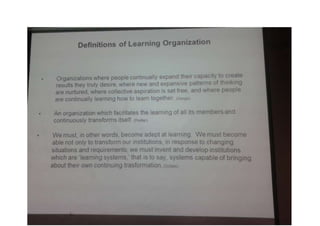

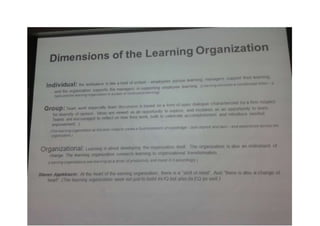
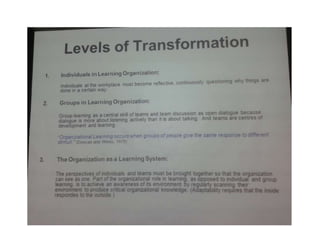
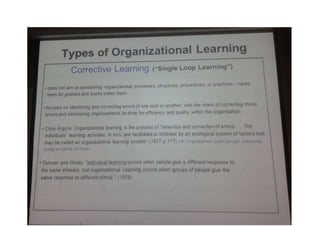
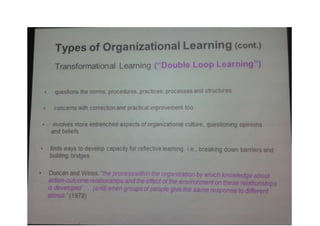
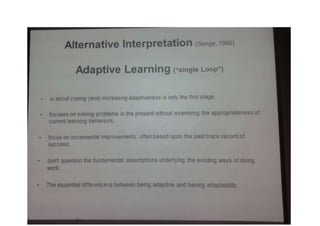

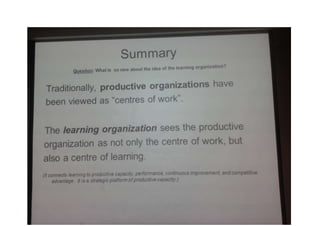
Ad
Recommended
Lecture 5 organisational learning
Lecture 5 organisational learningmoduledesign
Ěý
This document discusses organizational learning and knowledge management. It begins by outlining the learning objectives of explaining individual and team learning theories, distinguishing between knowledge acquisition, distribution, interpretation and organizational memory, and assessing the role of politics in organizational learning. It then covers various models of individual and organizational learning, including Kolb's learning cycle, single-loop and double-loop learning. It also discusses concepts like sensemaking, absorptive capacity, unlearning and organizational routines. The document is intended to provide foundational information on these topics to students taking a course on knowledge management.Knowledge management & organizations
Knowledge management & organizationsKaustubh Gupta
Ěý
This document discusses the role of organizational culture in knowledge management. It begins with definitions of knowledge management and discusses how it can benefit organizations by increasing efficiency, effectiveness, expertise and customer satisfaction. It then explains how knowledge in organizations can be either explicit or tacit. The document also discusses different frameworks for understanding organizational culture, such as the competing values framework, and how culture can impact a organization's approach to knowledge management, whether it takes a process-based approach that relies on formal systems or a practice-based approach that focuses on informal knowledge sharing. Finally, the document analyzes some case examples of knowledge management initiatives within a company and how cultural factors may have influenced their success or challenges.Defining Learning Organization
Defining Learning OrganizationRuchira Jayasinghe
Ěý
The document discusses the characteristics of a learning organization and strategies for guiding change processes within such an organization. It states that a learning organization is people-oriented, conducive to learning, and aims to transform and empower its members. It provides guidelines for leading change, such as understanding people's backgrounds and allowing for disagreement. Systems thinking and distinguishing issues from people are also recommended for managing conflict. Learning is positioned as an ongoing personal endeavor central to a learning organization.Organizational Learning
Organizational Learningahmad bassiouny
Ěý
1. Organizational learning is a process that enables organizations to better use the knowledge of their members to make business decisions.
2. It involves facilitating collaboration within the organization to encourage continuous improvement, empowering members to work as a cohesive team.
3. Key aspects of implementing organizational learning include encouraging lifelong learning, implementing team learning, and using increased knowledge to create new opportunities.Organisational Learning
Organisational LearningHillary Jenkins
Ěý
This document discusses the importance of organizational learning and creating a learning organization. It defines a learning organization as one where people at all levels are continually increasing their capacity to produce results they care about. A learning organization promotes information sharing between employees to create a more knowledgeable workforce that is flexible and able to accept new ideas and changes through a shared vision. It also discusses five disciplines that are important for organizational learning: systems thinking, personal mastery, mental models, building a shared vision, and team learning.Introduction to Knowledge Management
Introduction to Knowledge ManagementMiera Idayu
Ěý
The document provides an introduction to the topic of knowledge management (KM) through several presentations. It discusses the history and definitions of KM, elements of a KM initiative including people, processes and technology, and the importance of KM for competitive advantage. It also covers the evolution of KM, the differences between information management and KM, and addresses explicit and tacit knowledge as well as ethics in KM.Types of knowledge management systems
Types of knowledge management systemsNitin Reddy Katkam
Ěý
Knowledge Management Systems (KMS) are information systems designed to enhance organizational knowledge processes including creation, storage, retrieval, transfer, and application. Different types of KMS include expert systems for decision making, groupware for collaboration, document management systems for efficient document handling, decision support systems for informed decision-making, database management systems for data storage and retrieval, and simulation systems for modeling real-world scenarios. The document references foundational research and literature on KMS.Knowledge management
Knowledge managementSehar Abbas
Ěý
This document provides an overview of knowledge management. It defines data, information, and knowledge and describes explicit and tacit knowledge. It discusses the history of knowledge management from the 1970s to present. It also outlines several common knowledge management models and describes the typical stages in the knowledge management life cycle including information mapping, storage, retrieval, use, and auditing. Finally, it discusses some key terms used in knowledge management.knowledge management tools
knowledge management toolsAbin Biju
Ěý
1. The document discusses various IT and non-IT tools for knowledge management, including blogs for sharing information, virtual workspaces for collaboration, and social networks to connect people with similar interests.
2. It also covers advanced search tools, voice over internet protocol (VOIP) for communication, and knowledge portals to integrate different information sources.
3. Non-IT tools discussed are brainstorming, peer assist for sharing lessons learned, after action reviews to evaluate projects, communities of practice for sharing skills, and knowledge cafes and expertise locators to connect experts with those seeking knowledge.Knowledge management 4 (organizational learning)
Knowledge management 4 (organizational learning)David VALLAT
Ěý
The document discusses organizational learning, emphasizing the transition from individual to collective learning within organizations and the importance of avoiding common traps that hinder this process. It highlights concepts such as double-loop learning, espoused theory versus theory-in-use, and the impact of defensive reasoning on learning effectiveness. Key frameworks like Model I and Model II are presented, illustrating different approaches to organizational behavior and knowledge mobilization.Knowledge management
Knowledge managementPriyanka Velvijayan
Ěý
This document provides an overview of knowledge management. It defines knowledge management as a multi-disciplinary approach to achieving organizational objectives by making the best use of knowledge. It focuses on processes such as acquiring, creating, sharing knowledge and the cultural and technical foundations that support them. Knowledge management involves people who create and use knowledge, as well as processes, technologies, and artifacts to create, maintain, and access knowledge. The objectives of knowledge management are to explore its concepts and theory, learn about examples of its use, discuss its role in education and other fields, and identify controversies.Knowledge management (KM) tools
Knowledge management (KM) toolsDmitry Kudryavtsev
Ěý
The document discusses various knowledge management (KM) tools and practices, emphasizing the importance of selecting suitable tools aligned with company objectives and knowledge processes. It outlines methods for knowledge capture, codification, sharing, distribution, and evaluation, highlighting the significance of IT and non-IT tools in effective KM. The document also presents a framework for understanding the relationship between knowledge domains and the associated methodologies and tools.Learning organization
Learning organizationDivya Parmar
Ěý
This document discusses the concept of a learning organization. It defines a learning organization as a company that facilitates learning among its members and continuously transforms itself. It notes that the concept was coined by Peter Senge and others. The document outlines the nature, characteristics, core areas, and levels of learning organizations. It also discusses how to create a learning organization by establishing commitment to change, eliminating boundaries, developing a culture of openness, and incorporating employees into organizational challenges.Knowledge Management Overview
Knowledge Management Overviewsurulinathi
Ěý
The document discusses key concepts in knowledge management including definitions, types of knowledge, knowledge life cycles, learning styles, technologies, and roles in organizations like libraries. It defines knowledge management as planning, designing, building, operating and maintaining knowledge management systems to manage both explicit and tacit knowledge. Success requires leadership, culture, infrastructure and connecting people with information and each other.Knowledge Management Tools & Techniques
Knowledge Management Tools & TechniquesMichael Norton
Ěý
The document defines and describes various knowledge management tools and techniques including:
1) An after-action review evaluates and captures lessons learned through an informal discussion after a project or activity.
2) A case study provides key qualitative and quantitative information from a project through a structured written examination.
3) A community of practice is a network for people with common interests or problems to explore solutions and share ideas and good practices.
4) A gone well, not gone well gathers candid feedback at the end of an event through an open discussion of what worked and didn't work.Building a learning organization
Building a learning organizationKinnar Majithia
Ěý
The document discusses the key aspects of building a learning organization. It defines a learning organization as one that is skilled at problem solving, experimentation, learning from experience and others, and sharing knowledge. It identifies three critical factors for effective implementation - meaning, management, and measurement. It provides details on systematic problem solving as the first building block, emphasizing a scientific approach using data, tools, and asking the 5W questions. An example of Xerox's problem solving process is briefly analyzed.Knowledge management and learning organization
Knowledge management and learning organizationRajan Neupane
Ěý
Knowledge management and learning organizations were discussed. Knowledge was defined as representing reality based on adequate grounds. Knowledge management focuses on people who create and use knowledge, and the processes and technologies for knowledge creation, storage, and access. A learning organization is one where people continually expand their capacity to achieve desired results through shared visions and mental models, team learning, and personal mastery. Key benefits of knowledge management and learning organizations include competitive advantage through innovation and avoiding reinventing solutions.Role of hr in knowledge management final ppt
Role of hr in knowledge management final pptTanuj Poddar
Ěý
This document discusses the role of HR in knowledge management. It defines knowledge and knowledge management, and outlines the knowledge management processes. It discusses how HR can facilitate knowledge sharing through practices like job rotations, training, knowledge communities, and aligning incentives. The document argues that HR should drive a culture of collaboration and knowledge sharing through communication, workshops, and making knowledge management part of company training modules. HR is positioned as a key facilitator for institutionalizing knowledge management.Knowledge Management Lecture 1: definition, history and presence
Knowledge Management Lecture 1: definition, history and presenceStefan Urbanek
Ěý
1. Knowledge management aims to leverage collective wisdom to increase organizational responsiveness and innovation through the continuous flow of knowledge to the right people at the right time.
2. It involves strategies, tools, and techniques for managing both explicit knowledge that is recorded as well as tacit knowledge that resides within people.
3. Knowledge management has its roots in the recognition that much of an organization's valuable knowledge walks out the door, and emerged as a field in the 1980s with the proliferation of information technology.The learning organization presentation
The learning organization presentationrosinmary
Ěý
Peter Senge is an American scientist and author born in 1947. He introduced the concept of a learning organization in his 1990 book "The Fifth Discipline". A learning organization facilitates the continuous learning of its members to transform itself. It is a place where people discover how they create their reality. Organizational learning is important for companies to adapt to changing environments, improve skills and communication, and overcome weaknesses. Key components of learning organizations include systems thinking, personal mastery, mental models, shared vision, and team learning.Knowledge Management Presentation
Knowledge Management Presentationkreaume
Ěý
The document discusses knowledge management (KM) and its benefits. KM is defined as enabling individuals and teams to collectively create, share, and apply knowledge to achieve objectives. Benefits include reduced time-to-market, increased revenue and profit margins. Examples show companies saving billions through KM. Knowledge is formed from data and information, and can be explicit or tacit. Tacit knowledge is stored in people's minds while explicit knowledge is written down. KM tools and communities of practice help capture and share knowledge.Learning Organisation adapted from Peter Senge's 5th Discipline - Philosophy,...
Learning Organisation adapted from Peter Senge's 5th Discipline - Philosophy,...Yuvarajah Thiagarajah
Ěý
A learning organization is defined as one that creates, acquires, and transfers knowledge effectively, fostering an environment of continuous improvement and individual growth. Key aspects include strong leadership, a shared vision, systems thinking, and a culture that values trust and open communication. Barriers such as operational preoccupation and lack of empowerment can hinder the development of such organizations.Knowledge Management Lecture 4: Models
Knowledge Management Lecture 4: ModelsStefan Urbanek
Ěý
The document discusses various knowledge management models, including Nonaka and Takeuchi's framework, which emphasizes the processes of socialization, externalization, combination, and internalization in knowledge creation and sharing. It also covers concepts such as bounded rationality and Wiig's model that highlights the importance of knowledge completeness, connectedness, and congruency. Additionally, the document categorizes knowledge types into public, shared expertise, and personal knowledge.Practical Project Management - full course
Practical Project Management - full courseMarten Schoonman
Ěý
The three key principles of project management are planning, communication, and risk management. Planning involves defining the project activities, schedule, resources, and dependencies. Communication involves regularly informing all stakeholders about the project. Risk management involves identifying, evaluating, and mitigating potential risks to the project. Regular monitoring and adaptation are also important aspects of effective project management.Vision, Mission, Goals and Objectives: What's the Difference?
Vision, Mission, Goals and Objectives: What's the Difference?Johan Koren
Ěý
This document discusses the key differences between a vision, mission, goals, and objectives for a school library media center. A vision describes the desired future state, a mission explains what the organization does and for whom, goals are broad outcomes, and objectives are specific and measurable targets to achieve goals. The document provides examples and steps to develop each of these components to guide the direction and strategic planning of the school library media program.This is why students from these 44 institutions have not received National Se...
This is why students from these 44 institutions have not received National Se...Kweku Zurek
Ěý
This is why students from these 44 institutions have not received National Service PIN codes (LIST)Aprendendo Arquitetura Framework Salesforce - Dia 02
Aprendendo Arquitetura Framework Salesforce - Dia 02Mauricio Alexandre Silva
Ěý
Aprendendo Arquitetura Framework Salesforce - Dia 02
LDMMIA Shop & Student News Summer Solstice 25
LDMMIA Shop & Student News Summer Solstice 25LDM & Mia eStudios
Ěý
6/18/25
Shop, Upcoming: Final Notes to Review as we Close Level One. Make sure to review the orientation and videos as well. There’s more to come and material to cover in Levels 2-3. The content will be a combination of Reiki and Yoga. Also energy topics of our spiritual collective.
Thanks again all future Practitioner Level Students. Our Levels so far are: Guest, Grad, and Practitioner. We have had over 5k Spring Views.
https://ldm-mia.creator-spring.comMore Related Content
Viewers also liked (17)
knowledge management tools
knowledge management toolsAbin Biju
Ěý
1. The document discusses various IT and non-IT tools for knowledge management, including blogs for sharing information, virtual workspaces for collaboration, and social networks to connect people with similar interests.
2. It also covers advanced search tools, voice over internet protocol (VOIP) for communication, and knowledge portals to integrate different information sources.
3. Non-IT tools discussed are brainstorming, peer assist for sharing lessons learned, after action reviews to evaluate projects, communities of practice for sharing skills, and knowledge cafes and expertise locators to connect experts with those seeking knowledge.Knowledge management 4 (organizational learning)
Knowledge management 4 (organizational learning)David VALLAT
Ěý
The document discusses organizational learning, emphasizing the transition from individual to collective learning within organizations and the importance of avoiding common traps that hinder this process. It highlights concepts such as double-loop learning, espoused theory versus theory-in-use, and the impact of defensive reasoning on learning effectiveness. Key frameworks like Model I and Model II are presented, illustrating different approaches to organizational behavior and knowledge mobilization.Knowledge management
Knowledge managementPriyanka Velvijayan
Ěý
This document provides an overview of knowledge management. It defines knowledge management as a multi-disciplinary approach to achieving organizational objectives by making the best use of knowledge. It focuses on processes such as acquiring, creating, sharing knowledge and the cultural and technical foundations that support them. Knowledge management involves people who create and use knowledge, as well as processes, technologies, and artifacts to create, maintain, and access knowledge. The objectives of knowledge management are to explore its concepts and theory, learn about examples of its use, discuss its role in education and other fields, and identify controversies.Knowledge management (KM) tools
Knowledge management (KM) toolsDmitry Kudryavtsev
Ěý
The document discusses various knowledge management (KM) tools and practices, emphasizing the importance of selecting suitable tools aligned with company objectives and knowledge processes. It outlines methods for knowledge capture, codification, sharing, distribution, and evaluation, highlighting the significance of IT and non-IT tools in effective KM. The document also presents a framework for understanding the relationship between knowledge domains and the associated methodologies and tools.Learning organization
Learning organizationDivya Parmar
Ěý
This document discusses the concept of a learning organization. It defines a learning organization as a company that facilitates learning among its members and continuously transforms itself. It notes that the concept was coined by Peter Senge and others. The document outlines the nature, characteristics, core areas, and levels of learning organizations. It also discusses how to create a learning organization by establishing commitment to change, eliminating boundaries, developing a culture of openness, and incorporating employees into organizational challenges.Knowledge Management Overview
Knowledge Management Overviewsurulinathi
Ěý
The document discusses key concepts in knowledge management including definitions, types of knowledge, knowledge life cycles, learning styles, technologies, and roles in organizations like libraries. It defines knowledge management as planning, designing, building, operating and maintaining knowledge management systems to manage both explicit and tacit knowledge. Success requires leadership, culture, infrastructure and connecting people with information and each other.Knowledge Management Tools & Techniques
Knowledge Management Tools & TechniquesMichael Norton
Ěý
The document defines and describes various knowledge management tools and techniques including:
1) An after-action review evaluates and captures lessons learned through an informal discussion after a project or activity.
2) A case study provides key qualitative and quantitative information from a project through a structured written examination.
3) A community of practice is a network for people with common interests or problems to explore solutions and share ideas and good practices.
4) A gone well, not gone well gathers candid feedback at the end of an event through an open discussion of what worked and didn't work.Building a learning organization
Building a learning organizationKinnar Majithia
Ěý
The document discusses the key aspects of building a learning organization. It defines a learning organization as one that is skilled at problem solving, experimentation, learning from experience and others, and sharing knowledge. It identifies three critical factors for effective implementation - meaning, management, and measurement. It provides details on systematic problem solving as the first building block, emphasizing a scientific approach using data, tools, and asking the 5W questions. An example of Xerox's problem solving process is briefly analyzed.Knowledge management and learning organization
Knowledge management and learning organizationRajan Neupane
Ěý
Knowledge management and learning organizations were discussed. Knowledge was defined as representing reality based on adequate grounds. Knowledge management focuses on people who create and use knowledge, and the processes and technologies for knowledge creation, storage, and access. A learning organization is one where people continually expand their capacity to achieve desired results through shared visions and mental models, team learning, and personal mastery. Key benefits of knowledge management and learning organizations include competitive advantage through innovation and avoiding reinventing solutions.Role of hr in knowledge management final ppt
Role of hr in knowledge management final pptTanuj Poddar
Ěý
This document discusses the role of HR in knowledge management. It defines knowledge and knowledge management, and outlines the knowledge management processes. It discusses how HR can facilitate knowledge sharing through practices like job rotations, training, knowledge communities, and aligning incentives. The document argues that HR should drive a culture of collaboration and knowledge sharing through communication, workshops, and making knowledge management part of company training modules. HR is positioned as a key facilitator for institutionalizing knowledge management.Knowledge Management Lecture 1: definition, history and presence
Knowledge Management Lecture 1: definition, history and presenceStefan Urbanek
Ěý
1. Knowledge management aims to leverage collective wisdom to increase organizational responsiveness and innovation through the continuous flow of knowledge to the right people at the right time.
2. It involves strategies, tools, and techniques for managing both explicit knowledge that is recorded as well as tacit knowledge that resides within people.
3. Knowledge management has its roots in the recognition that much of an organization's valuable knowledge walks out the door, and emerged as a field in the 1980s with the proliferation of information technology.The learning organization presentation
The learning organization presentationrosinmary
Ěý
Peter Senge is an American scientist and author born in 1947. He introduced the concept of a learning organization in his 1990 book "The Fifth Discipline". A learning organization facilitates the continuous learning of its members to transform itself. It is a place where people discover how they create their reality. Organizational learning is important for companies to adapt to changing environments, improve skills and communication, and overcome weaknesses. Key components of learning organizations include systems thinking, personal mastery, mental models, shared vision, and team learning.Knowledge Management Presentation
Knowledge Management Presentationkreaume
Ěý
The document discusses knowledge management (KM) and its benefits. KM is defined as enabling individuals and teams to collectively create, share, and apply knowledge to achieve objectives. Benefits include reduced time-to-market, increased revenue and profit margins. Examples show companies saving billions through KM. Knowledge is formed from data and information, and can be explicit or tacit. Tacit knowledge is stored in people's minds while explicit knowledge is written down. KM tools and communities of practice help capture and share knowledge.Learning Organisation adapted from Peter Senge's 5th Discipline - Philosophy,...
Learning Organisation adapted from Peter Senge's 5th Discipline - Philosophy,...Yuvarajah Thiagarajah
Ěý
A learning organization is defined as one that creates, acquires, and transfers knowledge effectively, fostering an environment of continuous improvement and individual growth. Key aspects include strong leadership, a shared vision, systems thinking, and a culture that values trust and open communication. Barriers such as operational preoccupation and lack of empowerment can hinder the development of such organizations.Knowledge Management Lecture 4: Models
Knowledge Management Lecture 4: ModelsStefan Urbanek
Ěý
The document discusses various knowledge management models, including Nonaka and Takeuchi's framework, which emphasizes the processes of socialization, externalization, combination, and internalization in knowledge creation and sharing. It also covers concepts such as bounded rationality and Wiig's model that highlights the importance of knowledge completeness, connectedness, and congruency. Additionally, the document categorizes knowledge types into public, shared expertise, and personal knowledge.Practical Project Management - full course
Practical Project Management - full courseMarten Schoonman
Ěý
The three key principles of project management are planning, communication, and risk management. Planning involves defining the project activities, schedule, resources, and dependencies. Communication involves regularly informing all stakeholders about the project. Risk management involves identifying, evaluating, and mitigating potential risks to the project. Regular monitoring and adaptation are also important aspects of effective project management.Vision, Mission, Goals and Objectives: What's the Difference?
Vision, Mission, Goals and Objectives: What's the Difference?Johan Koren
Ěý
This document discusses the key differences between a vision, mission, goals, and objectives for a school library media center. A vision describes the desired future state, a mission explains what the organization does and for whom, goals are broad outcomes, and objectives are specific and measurable targets to achieve goals. The document provides examples and steps to develop each of these components to guide the direction and strategic planning of the school library media program.Learning Organisation adapted from Peter Senge's 5th Discipline - Philosophy,...
Learning Organisation adapted from Peter Senge's 5th Discipline - Philosophy,...Yuvarajah Thiagarajah
Ěý
Recently uploaded (20)
This is why students from these 44 institutions have not received National Se...
This is why students from these 44 institutions have not received National Se...Kweku Zurek
Ěý
This is why students from these 44 institutions have not received National Service PIN codes (LIST)Aprendendo Arquitetura Framework Salesforce - Dia 02
Aprendendo Arquitetura Framework Salesforce - Dia 02Mauricio Alexandre Silva
Ěý
Aprendendo Arquitetura Framework Salesforce - Dia 02
LDMMIA Shop & Student News Summer Solstice 25
LDMMIA Shop & Student News Summer Solstice 25LDM & Mia eStudios
Ěý
6/18/25
Shop, Upcoming: Final Notes to Review as we Close Level One. Make sure to review the orientation and videos as well. There’s more to come and material to cover in Levels 2-3. The content will be a combination of Reiki and Yoga. Also energy topics of our spiritual collective.
Thanks again all future Practitioner Level Students. Our Levels so far are: Guest, Grad, and Practitioner. We have had over 5k Spring Views.
https://ldm-mia.creator-spring.comOBSESSIVE COMPULSIVE DISORDER.pptx IN 5TH SEMESTER B.SC NURSING, 2ND YEAR GNM...
OBSESSIVE COMPULSIVE DISORDER.pptx IN 5TH SEMESTER B.SC NURSING, 2ND YEAR GNM...parmarjuli1412
Ěý
OBSESSIVE COMPULSIVE DISORDER INCLUDED TOPICS ARE INTRODUCTION, DEFINITION OF OBSESSION, DEFINITION OF COMPULSION, MEANING OF OBSESSION AND COMPULSION, DEFINITION OF OBSESSIVE COMPULSIVE DISORDER, EPIDERMIOLOGY OF OCD, ETIOLOGICAL FACTORS OF OCD, CLINICAL SIGN AND SYMPTOMS OF OBSESSION AND COMPULSION, MANAGEMENT INCLUDED PHARMACOTHERAPY(ANTIDEPRESSANT DRUG+ANXIOLYTIC DRUGS), PSYCHOTHERAPY, NURSING MANAGEMENT(ASSESSMENT+DIAGNOSIS+NURSING INTERVENTION+EVALUATION)) IIT KGP Quiz Week 2024 Sports Quiz (Prelims + Finals)
IIT KGP Quiz Week 2024 Sports Quiz (Prelims + Finals)IIT Kharagpur Quiz Club
Ěý
The document outlines the format for the Sports Quiz at Quiz Week 2024, covering various sports & games and requiring participants to Answer without external sources. It includes specific details about question types, scoring, and examples of quiz questions. The document emphasizes fair play and enjoyment of the quiz experience.HistoPathology Ppt. Arshita Gupta for Diploma
HistoPathology Ppt. Arshita Gupta for Diplomaarshitagupta674
Ěý
Hello everyone please suggest your views and likes so that I uploaded more study materials
In this slide full HistoPathology according to diploma course available like fixation
Tissue processing , staining etc
F-BLOCK ELEMENTS POWER POINT PRESENTATIONS
F-BLOCK ELEMENTS POWER POINT PRESENTATIONSmprpgcwa2024
Ěý
F-block elements are a group of elements in the periodic table that have partially filled f-orbitals. They are also known as inner transition elements. F-block elements are divided into two series:
1.Lanthanides (La- Lu) These elements are also known as rare earth elements.
2.Actinides (Ac- Lr): These elements are radioactive and have complex electronic configurations.
F-block elements exhibit multiple oxidation states due to the availability of f-orbitals.
2. Many f-block compounds are colored due to f-f transitions.
3. F-block elements often exhibit paramagnetic or ferromagnetic behavior.4. Actinides are radioactive.
F-block elements are used as catalysts in various industrial processes.
Actinides are used in nuclear reactors and nuclear medicine.
F-block elements are used in lasers and phosphors due to their luminescent properties.
F-block elements have unique electronic and magnetic properties.List View Components in Odoo 18 - Odoo şÝşÝߣs
List View Components in Odoo 18 - Odoo şÝşÝߣsCeline George
Ěý
In Odoo, there are many types of views possible like List view, Kanban view, Calendar view, Pivot view, Search view, etc.
The major change that introduced in the Odoo 18 technical part in creating views is the tag <tree> got replaced with the <list> for creating list views. How to Customize Quotation Layouts in Odoo 18
How to Customize Quotation Layouts in Odoo 18Celine George
Ěý
Customizing quotation layouts in Odoo 18 allows businesses to personalize their quotations to match branding or specific requirements. This can include adding logos, custom fields, or modifying headers and footers. Pests of Maize: An comprehensive overview.pptx
Pests of Maize: An comprehensive overview.pptxArshad Shaikh
Ěý
Maize is susceptible to various pests that can significantly impact yields. Key pests include the fall armyworm, stem borers, cob earworms, shoot fly. These pests can cause extensive damage, from leaf feeding and stalk tunneling to grain destruction. Effective management strategies, such as integrated pest management (IPM), resistant varieties, biological control, and judicious use of chemicals, are essential to mitigate losses and ensure sustainable maize production.LDMMIA Yoga S10 Free Workshop Grad Level
LDMMIA Yoga S10 Free Workshop Grad LevelLDM & Mia eStudios
Ěý
This is complete for June 17th. For the weekend of Summer Solstice
June 20th-22nd.
6/17/25: “My now Grads, You’re doing well. I applaud your efforts to continue. We all are shifting to new paradigm realities. Its rough, there’s good and bad days/weeks. However, Reiki with Yoga assistance, does work.”
6/18/25: "For those planning the Training Program Do Welcome. Happy Summer 2k25. You are not ignored and much appreciated. Our updates are ongoing and weekly since Spring. I Hope you Enjoy the Practitioner Grad Level. There's more to come. We will also be wrapping up Level One. So I can work on Levels 2 topics. Please see documents for any news updates. Also visit our websites. Every decade I release a Campus eMap. I will work on that for summer 25. We have 2 old libraries online thats open. https://ldmchapels.weebly.com "
Our Monthly Class Roster is 7,141 for 6/21.
ALL students get privacy naturally. Thx Everyone.
As a Guest Student,
You are now upgraded to Grad Level.
See Uploads for “Student Checkins” & “S9”. Thx.
Happy Summer 25.
These are also timeless.
Thank you for attending our workshops.
If you are new, do welcome.
For visual/Video style learning see our practitioner student status.
This is listed under our new training program. Updates ongoing levels 1-3 this summer. We just started Session 1 for level 1.
These are optional programs. I also would like to redo our library ebooks about Hatha and Money Yoga. THe Money Yoga was very much energy healing without the Reiki Method. An updated ebook/course will be done this year. These Projects are for *all fans, followers, teams, and Readers. TY for being presenting.Filipino 9 Maikling Kwento Ang Ama Panitikang Asiyano
Filipino 9 Maikling Kwento Ang Ama Panitikang Asiyanosumadsadjelly121997
Ěý
Filipino 9 Maikling Kwento Ang Ama Panitikang AsiyanoHow to use search fetch method in Odoo 18
How to use search fetch method in Odoo 18Celine George
Ěý
The search_fetch is a powerful ORM method used in Odoo for some specific addons to combine the functionality of search and read for more efficient data fetching. It might be used to search for records and fetch specific fields in a single call. It stores the result in the cache memory.Tanja Vujicic - PISA for Schools contact Info
Tanja Vujicic - PISA for Schools contact InfoEduSkills OECD
Ěý
Tanja Vujicic, Senior Analyst and PISA for School’s Project Manager at the OECD spoke at the OECD webinar 'Turning insights into impact: What do early case studies reveal about the power of PISA for Schools?' on 20 June 2025
PISA for Schools is an OECD assessment that evaluates 15-year-old performance on reading, mathematics, and science. It also gathers insights into students’ learning environment, engagement and well-being, offering schools valuable data that help them benchmark performance internationally and improve education outcomes. A central ambition, and ongoing challenge, has been translating these insights into meaningful actions that drives lasting school improvement. Public Health For The 21st Century 1st Edition Judy Orme Jane Powell
Public Health For The 21st Century 1st Edition Judy Orme Jane Powelltrjnesjnqg7801
Ěý
Public Health For The 21st Century 1st Edition Judy Orme Jane Powell
Public Health For The 21st Century 1st Edition Judy Orme Jane Powell
Public Health For The 21st Century 1st Edition Judy Orme Jane PowellBirnagar High School Platinum Jubilee Quiz.pptx
Birnagar High School Platinum Jubilee Quiz.pptxSourav Kr Podder
Ěý
Birnagar High School Platinum Jubilee Celebration QuizAd
